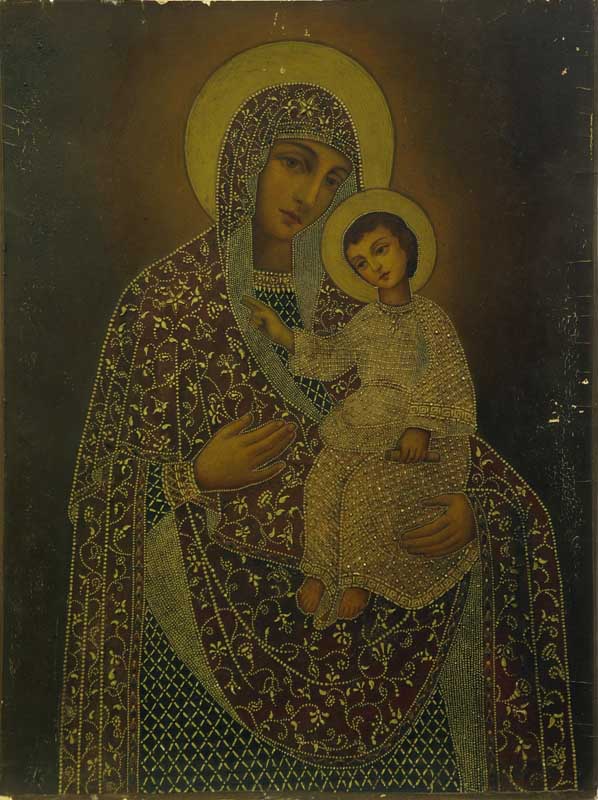  #Exhibit of the Month #Exhibit of the Month
August 2020
The icon of Our Lady of Hârbovăţ
 It is said that the icons, by the divine grace they have, choose their own places from where they can manifest their powers of blessing and consolation. It so happened that one icon of the Mother of God has remained on our lands from the end of the 18th century, when the battles of the Russo-Turkish war of 1787-1791 took place here. The circumstances of the appearance of this icon in Bessarabia are confirmed by several historical references, from which it follows that the Russian officer N.A. Albaduev, a participant in the military campaign, brought this icon here with him, and after his death his relatives – the colonel’s wife or his mother – gave this icon to the monastery, where he suddenly died when he came there on Christmas to receive communion. The icon of the Mother of God was initially placed in the old wooden church, where the officer’s grave was located, and then was placed in the new Church of the Assumption of the Blessed Virgin, built and consecrated in 1816. It is said that the icons, by the divine grace they have, choose their own places from where they can manifest their powers of blessing and consolation. It so happened that one icon of the Mother of God has remained on our lands from the end of the 18th century, when the battles of the Russo-Turkish war of 1787-1791 took place here. The circumstances of the appearance of this icon in Bessarabia are confirmed by several historical references, from which it follows that the Russian officer N.A. Albaduev, a participant in the military campaign, brought this icon here with him, and after his death his relatives – the colonel’s wife or his mother – gave this icon to the monastery, where he suddenly died when he came there on Christmas to receive communion. The icon of the Mother of God was initially placed in the old wooden church, where the officer’s grave was located, and then was placed in the new Church of the Assumption of the Blessed Virgin, built and consecrated in 1816.
Soon the icon became very popular, and its fame increased enormously thanks to the healings that occurred thanks to the intercession of the Mother of God; the names of the healed people, their place of residence and sufferings were described in periodicals. Archimandrite Seraphim, hegumen of the monastery in from 1805 to 1827, mentioned the special veneration of the icon of the Mother of God from the Hârbovăţ Monastery by Orthodox people who are always looking for help and intercession from this icon of the Empress of The World. Believers called it a wonder-making icon even before the Holy Synod issued Decree No. 526 of January 26, 1859, signed by Emperor Alexander II, proclaiming the icon of the Our Lady of Hârbovăţ as the Wonder-Making. Recognizing the miraculous properties of this icon, the Holy Synod also organized religious processions with the delivery of the icon to Chişinău on October 1 and its subsequent return to the monastery on April 23. The icon of the Mother of God of Hârbovăţ is one of the earliest and most popular types of the Theotokos icons, that of Hodegetria. In this iconographic depiction, the Mother of God and the Child are presented in a frontal position, looking at the one who is praying. The Mother of God holds the Child on Her left hand, and with Her right hand points to Him, the Child blesses with His right hand, holding in His left hand a sacred scroll – a symbol of the Gospel. Regarding the images, it should be said that the icons of the Herbovets Mother of God differ from the traditional icons of the Hodegetria type in a special relationship between the characters, their mutual affection is expressed in poses, in the tilt of the heads, in the gentle expression of the Child’s face. We can say that in the iconography of the Mother of God of Hârbovăţ, features of two different types of Theotokos are harmoniously combined: the Mother of God Hodegetria, or Our Lady of the Way, and the Mother of God Eleusa, or the Virgin of Tenderness. Exact copies of this icon are still kept in the summer church of the Noul Neamţ Monastery in the village of Chiţcani (Căuşeni), in the Intercession of the Blessed Virgin Church in the village of Sîrcova (Rezina), in the All Saints Church in Chişinău (early 20th century), in the Transfiguration Cathedral in Bolgrad, in the Transfiguration Monastery in Tatarbunary, in the Saint Paraskeva Church in the village of Furatovka (Odessa Oblast), in the Saint Archangel Michael Monastery in Odessa, in the Ascension Monastery in Teplodar (Ukraine), in the Holy Trinity Monastery in the village of Mramor, near Topolovgrad (Bulgaria), in the Holy Great Martyr Theodore Tyron Cathedral in Chişinău, in the Saint Prince Alexander Nevsky Cathedral in Ungheni, and other churches.
|





 The side panels are elegantly decorated with refined cast-iron elements in the Art Nouveau style, displaying the brand name - "Ideal." The Polyglott model, featuring a bilingual keyboard patented in the United Kingdom by Max Klaczko from Riga, Latvia, was produced between 1902 and 1913, marking the first typewriter capable of writing in two languages. The "Ideal Polyglott" typewriter was actively sold in the Russian Empire and gained significant popularity in Poland, Bulgaria, and Serbia.
The side panels are elegantly decorated with refined cast-iron elements in the Art Nouveau style, displaying the brand name - "Ideal." The Polyglott model, featuring a bilingual keyboard patented in the United Kingdom by Max Klaczko from Riga, Latvia, was produced between 1902 and 1913, marking the first typewriter capable of writing in two languages. The "Ideal Polyglott" typewriter was actively sold in the Russian Empire and gained significant popularity in Poland, Bulgaria, and Serbia.













































